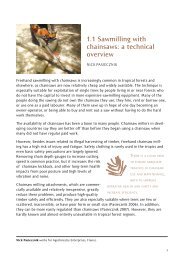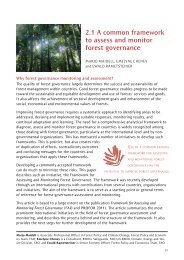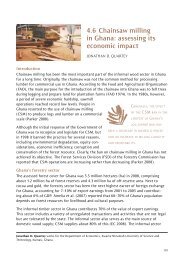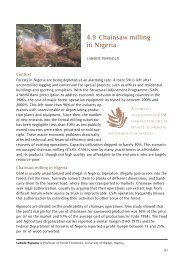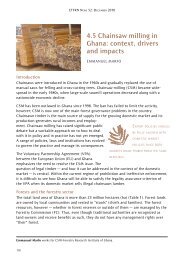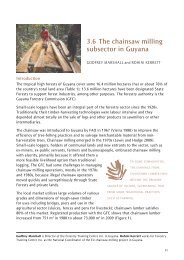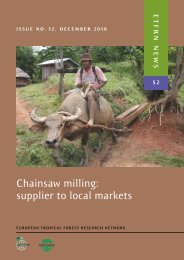Chainsaw milling: supplier to local markets - European Tropical ...
Chainsaw milling: supplier to local markets - European Tropical ...
Chainsaw milling: supplier to local markets - European Tropical ...
You also want an ePaper? Increase the reach of your titles
YUMPU automatically turns print PDFs into web optimized ePapers that Google loves.
2.5 FiNaNcial aNalysis oF small-scalE haRvEsTiNg iN papua NEw guiNEa<br />
Financial modeling<br />
a financial model was developed <strong>to</strong> evaluate the performance of these different production<br />
models over 20 years. The performance of each production model was assessed using<br />
the following criteria:<br />
1. profitability in each of the first three years of operation;<br />
2. average return on sales (or profits as a percentage of sales) over the 20-year period;<br />
3. funds required <strong>to</strong> purchase the equipment and provide working financing;<br />
4. the payback period (the number of years it takes <strong>to</strong> repay the start-up investment<br />
costs from the free cash flow generated by the operation);<br />
5. accumulated profits during<br />
a) the first five years of operation, and<br />
b) over the 20-year period.<br />
6. net present Value (npV) – excess or shortfall of the stream of cash flows expected<br />
over the 20-year life of the operation, assuming a discount rate of 20%.<br />
Financial model assumptions and data<br />
The study assumed that the community owned the forest, paying no stumpage cost or log<br />
royalties <strong>to</strong> the government and that all sawn timber was sold. no time was included for<br />
replanting with natural regeneration; applying selective harvesting and ril is assumed <strong>to</strong><br />
provide for forest regeneration. The time required <strong>to</strong> start up the business was considered<br />
<strong>to</strong> be free time. Communities bear the full cost of certification. There was no financial value<br />
included for other non-timber forest benefits. production per sawmill varied between 1<br />
and 3 m 3 /day (depending on terrain, tree species and level of mechanization). production<br />
was assumed <strong>to</strong> occur on 173 days per year, which accounts for the wet season and breaks<br />
for other community needs. it was assumed that communities used existing roads; road<br />
construction costs (generally very high in pnG) were not included in the analysis (Table 1).<br />
Timber prices were established from surveys and interviews with various merchants and<br />
companies. These were adjusted over time according <strong>to</strong> the assumed inflation rate (see<br />
below):<br />
• class 1, a grade green sawn timber sold <strong>local</strong>ly, pnGk 1000/m³, exported pnGk 1300<br />
per m³, dried and dressed pnGk 2000/m³ (same price in <strong>local</strong> or export <strong>markets</strong>);<br />
• class 1, b grade green sawn timber, pnGk 650/m³, dried and dressed material pnGk<br />
1300/m³;<br />
• mixed hardwoods, a grade, pnGk 500/m³; and<br />
• mixed hardwoods, b grade pnGk 400/m³.<br />
45



